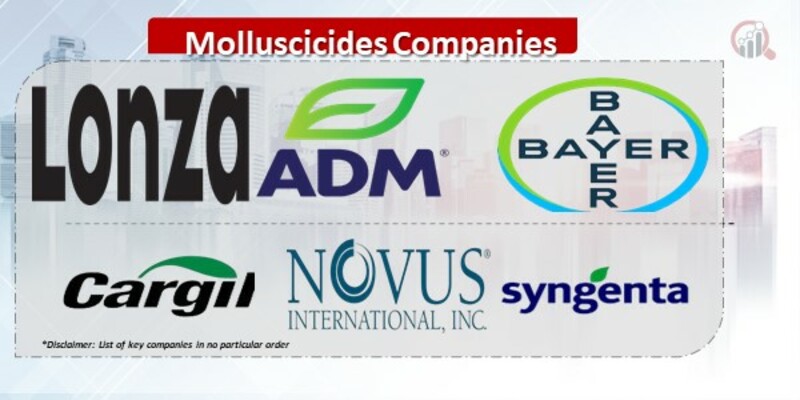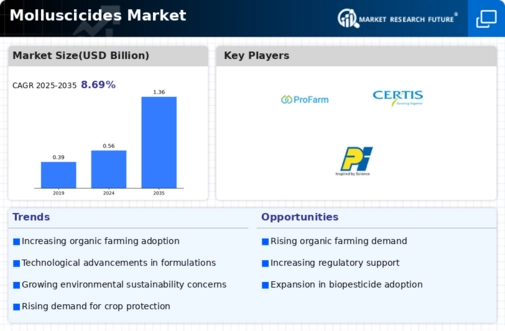Top Industry Leaders in the Molluscicides Market
Global Molluscicides Market Outlook

The competitive landscape of the molluscicides market is dynamic and evolving, driven by a growing need for effective pest control solutions in agriculture and horticulture. Molluscicides play a crucial role in protecting crops from mollusks, such as snails and slugs, which can cause significant damage to agricultural produce. As the demand for sustainable and eco-friendly pest control methods increases, the market is witnessing intensified competition among key players.
Some of the prominent players in the molluscicides market include
- Lonza Group AG
- Bayer Cropscience AG
- BASF SE
- ADAMA Agricultural Solutions
- Marrone Bio Innovations
- American Vanguard Corporation
- De Sangosse Ltd
- Neudorff GmbH KG
- Doff Portland Ltd
- Certis Europe
- Syngenta AG
- PI Industries Ltd.
- Amvac Chemical Corporation
- Chiltern Farm Chemicals Ltd.
- Westland Horticulture Ltd
These industry leaders have established themselves through years of research, development, and strategic partnerships. Bayer Crop Science, for instance, has a robust portfolio of molluscicides, including metaldehyde-based products that are widely used for snail and slug control. Lonza Group focuses on delivering innovative solutions with a focus on sustainability, aiming to meet the increasing demand for environmentally friendly pest control options.
The strategies adopted by key players in the molluscicides market revolve around product development, strategic collaborations, and market expansion. Companies are investing heavily in research and development to introduce advanced formulations that are both effective and environmentally friendly. Collaborations with research institutions and regulatory bodies are becoming more prevalent to ensure compliance with evolving environmental regulations. Marrone Bio Innovations, known for its focus on bio-based solutions, collaborates with various organizations to enhance its product offerings and expand its market reach.
Market share analysis in the molluscicides sector is influenced by several factors, including product efficacy, regulatory approvals, pricing strategies, and distribution networks. Companies that can effectively address these factors are likely to gain a competitive edge. Additionally, the ability to adapt to changing market trends, such as the increasing preference for organic and bio-based molluscicides, is crucial for sustaining and expanding market share.
New and emerging companies are entering the molluscicides market, driven by the increasing demand for innovative and sustainable pest control solutions. These companies are leveraging cutting-edge technologies and novel formulations to differentiate themselves in the highly competitive landscape. The emergence of start-ups and smaller players is contributing to the diversification of product offerings and fostering innovation in the market. With a focus on niche segments and specific regional markets, these companies are challenging established players and reshaping the competitive dynamics of the molluscicides industry.
Industry news in the molluscicides market reflects ongoing developments, regulatory changes, and advancements in research and technology. For instance, regulatory approvals for new formulations or active ingredients often impact market dynamics. Additionally, breakthroughs in biopesticides and integrated pest management solutions are gaining attention as the industry strives to reduce reliance on conventional chemical pesticides. The market is also witnessing collaborations between companies and academic institutions to explore novel approaches to mollusc control.
Current company investment trends in the molluscicides market indicate a significant focus on sustainability, technology integration, and global market expansion. Companies are investing in research to develop molluscicides with reduced environmental impact, ensuring compliance with stringent regulations. The integration of digital technologies for precision farming and pest monitoring is gaining traction, allowing companies to offer more targeted and efficient solutions. Furthermore, investments in marketing and distribution channels are aimed at expanding the geographical reach of molluscicides, especially in emerging markets with a high potential for agriculture.
Competitive Scenario in the molluscicides market is characterized by a mix of established players, emerging companies, and technological innovators. The market is expected to witness increased consolidation activities as larger companies seek to enhance their product portfolios and expand their global presence. Strategic partnerships, mergers, and acquisitions are likely to shape the competitive landscape in the coming years as companies strive to strengthen their market positions and gain a competitive advantage.
Recent News
Molluscicides: Tiny Foes, Big Innovations
Mollusks may be small and slimy, but they can pack a big punch when it comes to agricultural damage. Slugs and snails munch their way through crops, costing farmers millions each year. Thankfully, the fight against these tiny terrors is getting a major upgrade, with new and innovative molluscicide solutions emerging on the scene.
Slug-Stopping Science:
Targeted toxins: Gone are the days of broad-spectrum chemicals harming beneficial insects and soil organisms. Scientists are developing molluscicide baits with active ingredients that specifically target the nervous systems of slugs and snails, leaving other creatures unharmed.
Natural warriors: Nature is full of mollusc-munching marvels. Researchers are harnessing the power of predatory nematodes, microscopic worms that seek out and devour slugs and snails. This eco-friendly approach offers a sustainable solution without chemical residues.
Tech to the rescue: Precision agriculture is making its way into mollusc control. Smart traps equipped with sensors can detect slug activity and release targeted doses of molluscicide, minimizing waste and maximizing effectiveness.









